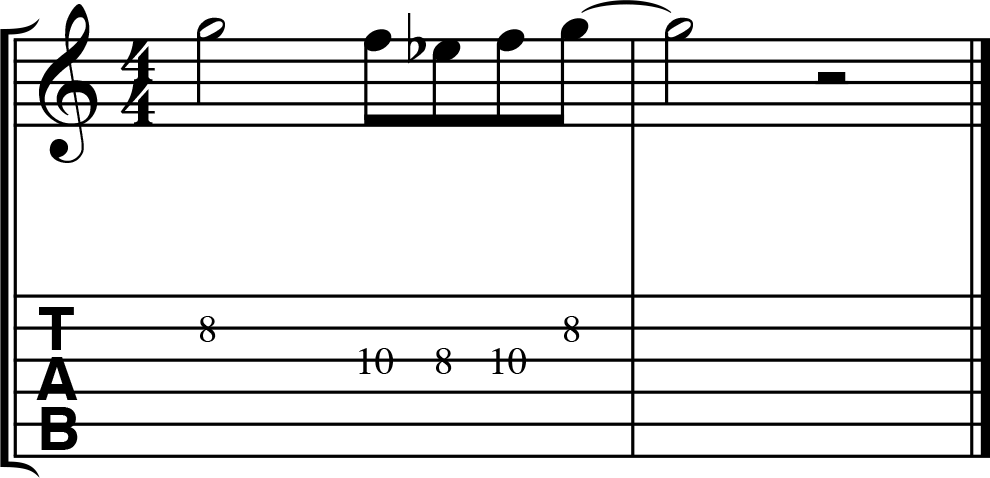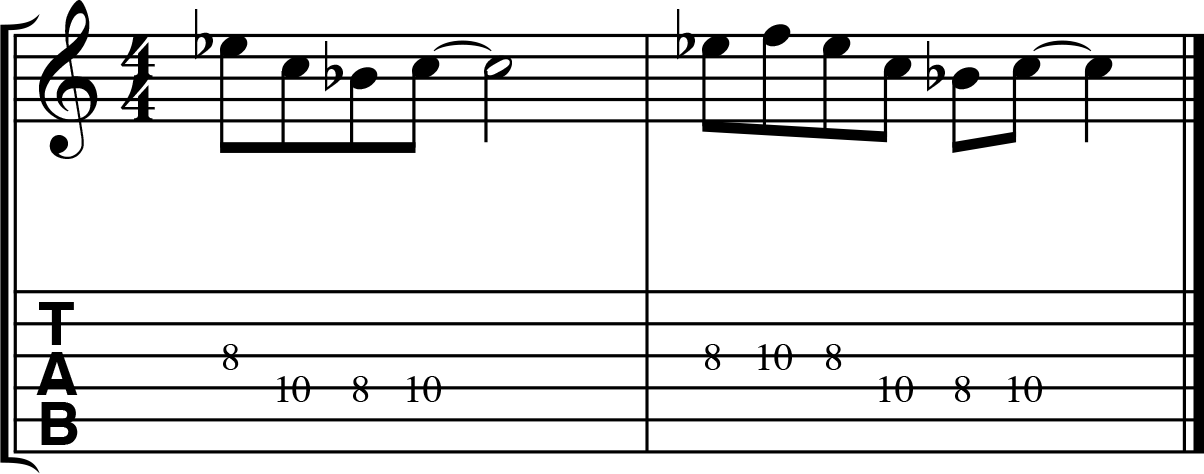Improvising Over a Blues

Hi. This is Hub Guitar.
Let's try improvising over a blues progression.
Many of the blues greats who defined the genre didn't have a huge amount of guitar technique. They didn't necessarily rely on speed or playing a lot of notes for their improvised solos. It was more important to play with "soul", injecting that bluesy feeling into every note.
We're going to try this on a C blues. The chords are gonna be C7 to F7, with G7, like that, coming back to C7.
So let's take a couple of small melodies, called licks or riffs, and try to build on them. Just as a note, I'm going to play these at a literal way and I'm going to give you some music notation to show you how to play them, but we are going to treat them pretty flexibly and change the time and rhythm as well.
Here's the first one.
Now I can repeat it, add some variations, change some notes, change the rhythm. And here is the second one. And again I'm going to manipulate that lick a lot until it's not even close to resembling the original lick. So I'm going to keep these two ideas as my center. If I get lost, I'll come back to one of those two. Don't be afraid to repeat yourself. It should be easy to repeat the same 5 notes, right? But a lot of people are afraid to repeat it. It can takes them decades to overcome that fear sometimes. Just repeat yourself! If it sounded good once, it'll probably sound good again.
So I can also just sit here and come up with 10 or 20 variations to play before I start the track. That will give me some idea of what I'm going to do.
Don't be afraid to be silent, either. When you stop playing, listen to the sound of your own silence. It sounds good! Sometimes the best melody is just a nice stretch of silence. So you can repeat those ideas, add variations, change the notes and change the rhythm. But try to have some ideas that you keep as the center. If you get lost, you can come back to that idea. So I am going to do an example using a C blues backing track.
So don't be afraid to repeat yourself. It should be easy to repeat the same 5 notes, right? But a lot of people are afraid to repeat it. It can takes them decades to overcome that fear sometimes. Just repeat yourself! If it sounded good once, it'll probably sound good again. Practice these motifs, and see if you can come up with your own. Don't be afraid to leave space between the notes and repeat yourself. And most of all, have fun.
The blues began as a unique genre of popular music but is now considered to be the basis of rock and pop. For the purpose of this lesson, the blues will describe a popular chord progression and the scale used to improvise with that chord progression.
Unless otherwise specified, a blues is most-often a 12-bar progression of chords.
Basic 12-Bar Blues
| I7 |  |
 |
 |
| IV7 |  |
I7 |  |
| V7 | IV7 | I7 |  |
How the Chords Are Built
All of the blues chords are dominant-seventh chords. These chords are built from the first, fourth and fifth chords of the key. In the key of C, we’d have:
| 1 | 2 | 3 | 4 | 5 | 6 | 7 | 8 |
| C | D | E | F | G | A | B | C |
This gives us the chord progression C7, F7 and G7. Placing those into the chord progression above produces a C blues:
| C7 |  |
 |
 |
| F7 |  |
C7 |  |
| G7 | F7 | C7 |  |
Try playing this chord progression with barre chords.
We can also extend the harmony by adding tensions 9 and/or 13 to each chord:
| C13 |  |
 |
 |
| F13 |  |
C13 |  |
| G13 | F13 | C13 |  |
Each of these chords can be played using the Advanced Barre Chords forms.
What Notes Are Used to Improvise?
The scale most commonly played on this blues is a minor pentatonic scale from the same root as the tonic chord. So this C Blues would be played with a C minor pentatonic scale.
You can also normally use a C major pentatonic scale, and mix it with the minor pentatonic, too. Confused? Check out this lesson for more information about scales to play over a blues progression.
Let’s try using a few simple motifs—short musical ideas—to improvise over this progression. Each motif will be based on the C minor pentatonic scale, and so each motif can be played over every chord in the progression.
Motif A

Motif B

Backing Track: C Blues
The backing track is 3:00 minutes long and has drums, bass, guitar and piano. The form is as described above. There is a fill in the track at the end of each 12-bar chorus that signals the start of a new repeat.
Blues Improvisation Exercises
- Listen to the backing track and follow along with the chord progression above. Say the names of the chords out loud as the chords change.
- Play the chords along with the backing track.
- Play the C minor pentatonic scale up and down.
- Play the C major pentatonic scale up and down.
- Play “Motif A” over each chord.
- Play “Motif B” over each chord.
- Play “Motif A”, but change the notes of the motif (start and end on different notes.)
- Play the notes of the motifs, but change the rhythms. You can use any eighth note rhythm. Be sure to swing it a bit!
 As the creator of Hub Guitar, Grey has compiled hundreds of guitar lessons, written several books, and filmed hundreds of video lessons. He teaches private lessons in his Boston studio, as well as via video chat through TakeLessons.
As the creator of Hub Guitar, Grey has compiled hundreds of guitar lessons, written several books, and filmed hundreds of video lessons. He teaches private lessons in his Boston studio, as well as via video chat through TakeLessons.